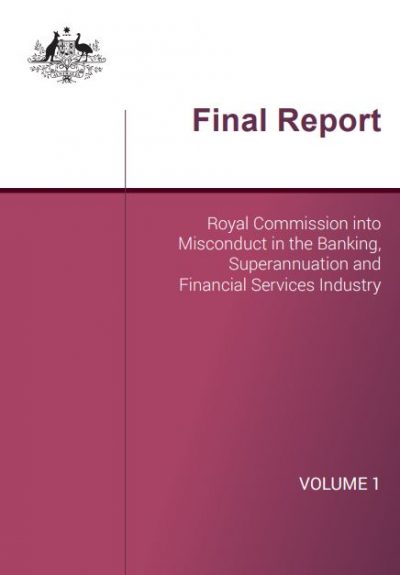ERM learnings from the financial advice ‘Fees for No Service’ scandal
The recent Royal Commission into Misconduct in the Banking, Superannuation and Financial Services Industry used case studies to highlight examples of misconduct. With reference to one such case study known as the Fees For No Service issue, Tim Gorst outlines three important lessons for any actuary wishing to develop their Enterprise Risk Management skill set.
The recent Royal Commission into Misconduct in the Banking, Superannuation and Financial Services Industry (Royal Commission) discussed at length case studies designed to highlight examples of misconduct. For any actuary wishing to develop their Enterprise Risk Management (ERM) skill set, these case studies provide important lessons particularly in relation to the management of conduct risk.
One such case study has become known as the Fees For No Service (FFNS) issue. Over the last decade many who sought and obtained advice from a financial adviser, and many members of superannuation funds, were charged ongoing fees for services that were not provided. In its worst form, this included isolated incidences of the charging of the estate of deceased people for financial advice, as was so publicly revealed through the Royal Commission.
“… charging for what you do not do is dishonest. Although this should have been obvious to everyone, the practice of charging ‘fees for no service’ has been endemic in the financial advice industry.”
– Royal Commission Final Report – Volume 1, Page 134
So far, the issue has been predominantly linked to the wealth management businesses of the 4 major banks, AMP and StatePlus Super, with ASIC expecting over $1b ultimately needing to be returned to customers. As important as the impact to financial capital is the impact to social capital across the financial services industry, as highlighted so effectively in the final Royal Commission report “Until satisfactory steps have been taken to deal with those involved in the charging of ‘fees for no service’, and to ensure that it does not happen again, the financial advice industry will lack the public respect and trust that is a necessary aspect of any profession.” Such a strong conclusion might help explain both the string of high profile Royal Commission related resignations, and share price impacts, across some of the entities responsible.
Working through this case study highlights three key elements that are critical in ensuring a risk management framework (RMF) effectively manages FFNS related risks.
-
Risk culture, governance and remuneration – all critical and deeply interconnected
Traditionally risk governance and risk culture might have been noted as largely separate RMF components. The Final Report highlighted that governance and culture are inextricably linked and informed by a third critical driver of remuneration structures. “Failings of organisational culture, governance arrangements and remuneration systems lie at the heart of much of the misconduct examined in this Commission …… regulators also have an important role to play in the supervision of culture, governance and remuneration.”
In relation to culture, the case study highlighted the importance of management and the Board being decisive in taking due accountability for historical conduct related issues. The reluctance in some cases of management and the Board to work with ASIC constructively and with speed to deploy appropriate remediation methodologies was seen as a “red flag” of deficient risk culture.

In relation to governance, there was a sense that Boards (including Superannuation Trustee Boards) did not get involved early enough, or show appropriate duty of care, to both identify the issue and proactively address regulator concerns around the approach and timing of the subsequent need for customer remediation. This social risk profile reached critical levels at the height of the Royal Commission as daily headlines incurred the rightful disdain of the community, concurrent with an increasingly strained working relationship between the industry and ASIC around the issue. In one case the Royal Commission commented on the “… abiding blindness to the seriousness of the underlying conduct” referring to complacency around Board accountability to protect customer interests.
In relation to remuneration structures and how they contributed to the original FFNS issue, the Final Report commented that the “… adviser stands to earn, and to continue to earn, annual amounts from the client. The less the adviser does before the fee is paid, the greater the financial advantage.” It is this passive income stream from disengaged customers, on which the advice industry had become so reliant, that again contributed to general complacency around addressing FFNS related risks and issues.
-
Risk management systems and control processes – must exist and be effective
 The case study documented examples of either the absence, or ineffective working, of risk management controls that could have flagged where a customer was being charged for a service they had not received. Whilst the Royal Commission focussed predominantly on misconduct as a contributing factor, the impact of adviser payments being made through generally older style products, originally designed in a different regulatory era (pre the 2015 Future of Financial Advice, or FOFA, regulations), and on legacy systems which have become difficult to update, should not be underestimated. It highlights the importance of the financial services industry (including their actuaries) finding a way to modernise its products, systems and risk controls into a much simpler, open and transparent design.
The case study documented examples of either the absence, or ineffective working, of risk management controls that could have flagged where a customer was being charged for a service they had not received. Whilst the Royal Commission focussed predominantly on misconduct as a contributing factor, the impact of adviser payments being made through generally older style products, originally designed in a different regulatory era (pre the 2015 Future of Financial Advice, or FOFA, regulations), and on legacy systems which have become difficult to update, should not be underestimated. It highlights the importance of the financial services industry (including their actuaries) finding a way to modernise its products, systems and risk controls into a much simpler, open and transparent design.

-
Policy and regulatory standards – must be customer centric
The Royal Commission recommended that the law needs to be changed to ensure consumers are protected against FFNS related risks by ensuring that amongst other things an advice customer has the opportunity to renew annually ongoing fee arrangements with their adviser. Further the Royal Commission recommended provisions put in place under FOFA to enable the grandfathering of legacy “conflicted remuneration” arrangements with customers, irrespective of whether a service is required to receive this payment, be repealed. These changes highlight the importance of consumer centric regulatory and internal Board Policy requirements to ensure customers are protected.
In conclusion, an assessment of the Royal Commission FFNS case study highlights how;

- better alignment between risk culture, governance and remuneration structures,
- improved FFNS risk control design and operational effectiveness (both preventative and detective controls), and;
- more customer centric internal policy and external regulatory standards, could have all helped improve the historical management of FFNS related risks.
CPD: Actuaries Institute Members can claim two CPD points for every hour of reading articles on Actuaries Digital.






